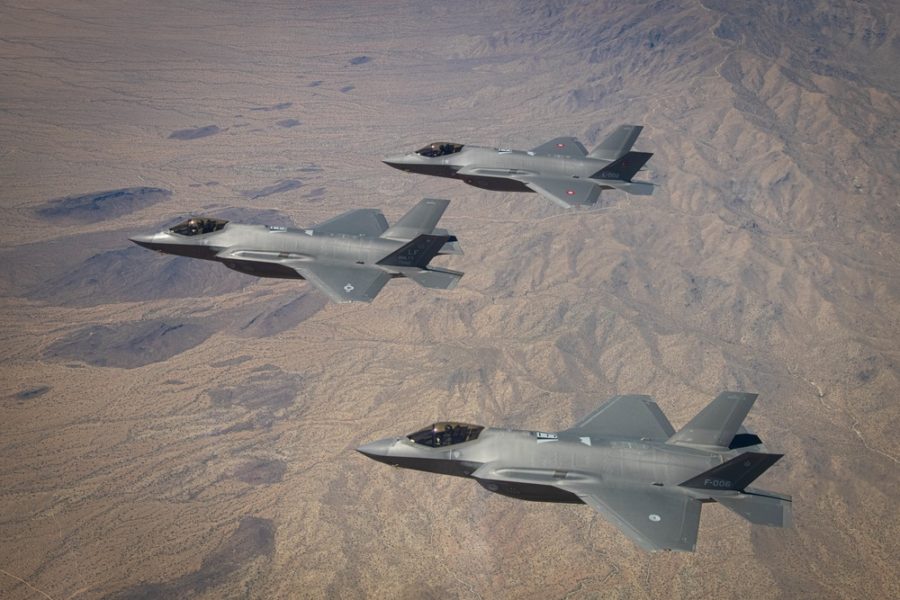Due to the prolonged delay in deliveries of the Tech Refresh 3 version of the F-35 fighter, Denmark is pulling six of its TR-2-configured F-35 jets stationed in the U.S. back to home base in order to consolidate aircraft and get better training for its pilots and maintainers, the Danish defense ministry announced.
Danish defense minister Troels Lund Poulsen said the move “makes it possible to increase the training level” of F-35 ground and flight crews. The aircraft will join four already in Denmark, at Skydstrup air base, for a total of 10. Poulsen also said Denmark has NATO obligations which must be met.
The Royal Danish Air Force aircraft have been based at Luke Air Force Base, Ariz., which is the centralized training location for all international users of the F-35A. The ministry said it is making the change because it needs to keep on track with training for its F-35 fleet, especially since it has promised some of its retiring F-16s to Ukraine.
Poulsen said the jets will be replaced at Luke by new TR-3 models as soon as they become available.
“We have now found a solution so that the delays from the manufacturer affect us as little as possible,” Poulsen said. He did not specify a timeline for the move.
He added that it is “absolutely crucial that we follow the phase-in” of the F-35 closely because the system is “a major investment for Denmark which will affect our defense and security for many years to come.”
The action comes as the Joint Program Office gets ready to approve deliveries of F-35s—on hold since last summer—with a “truncated” version of the TR-3 hardware and software package. The JPO is expected to inform Congress in the coming weeks that the truncated package is deemed safe for training. Program Executive Officer Lt. Gen. Michael Schmidt has been waiting for the test enterprise to certify that the package is stable and doesn’t require an excessive number of in-flight reboots.
Certifying the package will allow Lockheed Martin to resume deliveries of some 85 aircraft that have been parked in storage since last summer.
Once deliveries are underway, it could take as much as a year to get through the handover process for the jets, which amount to more than six months’ production. Lockheed has said it expects to deliver at least one per day once transfers resume, but the Government Accountability Office recently said it has never previously hit that pace.
Denmark has agreed to sell 24 of its 43 F-16A/B aircraft to Argentina, with the remainder going to Ukraine. The first aircraft have already been delivered to Argentina, and NATO officials have said Ukraine will get its first F-16s in the next few months, pending the completion of pilot and maintainer training, some of which is taking place in the U.S.
Denmark plans a force of 27 F-35s. The remaining 17 aircraft are to be delivered by 2027.
The hold on deliveries has affected all users of the F-35, and its duration—now in its 10th month—has disrupted the change-out of old equipment for new and the assignment of personnel in most user countries.
The TR-3 upgrade is the processor and software foundation for the Block 4 upgrade, a series of more than 80 improvements to electronic warfare, processor power, displays and weapons, to name just a few. Schmidt told Congress during budget hearings in the spring that the Block 4 will have to be “reimagined,” with some updates now not coming until the early 2030s.
The F-35 training enterprise at Luke generates aircraft from an international pool. Student pilots are given the next jet available, so F-35s are routinely flown by pilots whose countries don’t own the jets they’re flying. It isn’t yet clear how the absence of six Danish jets from the pool will affect the training enterprise.
Lockheed received a $1.56 billion F-35 contract from the Pentagon on June 27, but program officials said this had to do exclusively with sustainment efforts of fielded aircraft and did not include any progress payments having to do with development or aircraft deliveries.
The contract covered ground maintenance activities, depot support, the automatic logistic information system (ALIS) operations, reliability and maintainability activities, supply chain management and pilot training, among other items. Some $405 million of the award covers Air Force operations and $124 million covers Foreign Military Sales support to non-U.S. user nations.
